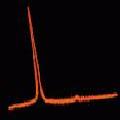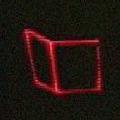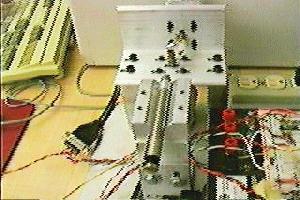-

-
Courses
Find courses by:
Collections
Cross-Disciplinary Topic Lists
- About
- Donate
- Featured Sites
This is an archived course. A more recent version may be available at ocw.mit.edu.
All photos on this page courtesy of Bernado Aumond and Razman Zambri. Used with permission.

The laser display was developed in the Spring of 97 as a completion hands-on project for the Designing Smart Machines class, taught by Professor Trumper.
The setup consists of two high speed scanners by General Scanning onto which two mirrors are mounted. The scanners are driven by power coming from a PA45 amplifier.
The relative position between mirrors is so that a laser beam (coming from an ordinary laser pointer) bounces on the two reflective surfaces and reaches the ceiling.
The motion of one of the mirrors corresponds to an "X" displacement on an imaginary axis on the ceiling. The motion of the other one creates a "Y" displacement.
An inverse kinematics scheme was implemented on a 486 computer. This scheme "translates" desired X-Y displacements on the ceiling into desired mirror positions, to be commanded to the scanners.
The control scheme is based on an analog double lead compensator for each scanner. The rising time obtained was about 4msec.




Check this 20 sec movie with one actual display in motion. (MPEG) (Text and images courtesy of Bernado Aumond and Razman Zambri. Used with permission.)
In this display, a Fourier transform of a signal coming from an FM radio is plotted on the ceiling. The sound is captured by an AD converter and then real time processed by the computer. Finally, the trace is displayed. See picture above, on the left.

In this display, isometric projections of 3-D objects such as pyramids and cubes were plotted. The objects can rotate in any direction and also shrink or increase in size. A movie capture of the actual display, portraying the objects and "MIT" rotating in various directions is available. (MPEG) (Text and images courtesy of Bernado Aumond and Razman Zambri. Used with permission.)
